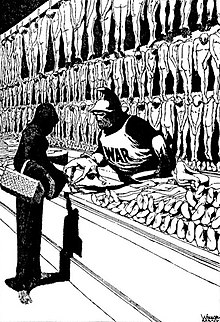Opposition to World War I
Opposition to World War I was widespread during the conflict and included socialists, such as anarchists, syndicalists, and Marxists, as well as Christian pacifists, anti-colonial nationalists, feminists, intellectuals, and the working class.
The main official groups supported the war but it was opposed by a number of prominent women's rights campaigners, including Helena Swanwick, Margaret Ashton, Catherine Marshall, Maude Royden, Kathleen Courtney, Chrystal Macmillan,[5] and Sylvia Pankhurst.
In 1915, the League of Nations Society was formed by British Liberal Party leaders to promote a strong international organization that could enforce the peaceful resolution of conflict.
Hamilton Holt published an editorial in his New York City weekly magazine The Independent called "The Way to Disarm: A Practical Proposal" on 28 September 1914.
It called for an international organization to agree upon the arbitration of disputes and to guarantee the territorial integrity of its members by maintaining military forces sufficient to defeat those of any non-member.
[7] Jeannette Rankin, the first woman elected to Congress, was another fierce advocate of pacifism, the only person to vote no to America's entrance into both World Wars.
[9] Many socialist groups and movements were antimilitarist, arguing that war by its nature was a type of governmental coercion of the working class for the benefit of capitalist elites.
On the far-left the radical French pacifist Gustave Hervé promoted building anti-government militias and instigating mutinies in the army.
Jaurès particularly warned of the potential for a diversionary war.Alarmed by the growth of the socialist movement, a government might attempt to create a foreign diversion rather than directly battle Social Democracy.
If a war breaks out in this way between France and Germany, would we permit the French and German proletariat to murder one another on behalf of the capitalists and for their benefit without Social Democracy attempting to exert the greatest effort to stop it?
Jaurès criticized Marx and Engels' maxim that the "workers have no Fatherland" as "vain and obscure subtleties" and a "sarcastic negation of history itself".
In Britain, the prominent peace activist Stephen Henry Hobhouse went to prison for refusing military service, citing his convictions as an "International Socialist and, a Christian"[20] On 5 August, the Parliamentary Labour Party in the United Kingdom voted to support the government in the war.
"[23] One of them was Bertrand Russell - a mathematician, philosopher and social critic engaged in pacifist activities, who was dismissed from Trinity College, Cambridge, following his conviction under the Defence of the Realm Act in 1916.
The CWC led the campaign against the coalition government in which David Lloyd George was a prominent member, and their Munitions Act, which forbade engineers from leaving the company they were employed in.
The CWC negotiated with government leaders, but no agreement could be reached and consequently both Gallacher and Kirkwood were arrested and imprisoned under the Defence of the Realm Act.
[25] Other notable opponents to Conscription included the Catholic Archbishop of Melbourne Daniel Mannix, the Queensland Labor Premier Thomas Ryan, Vida Goldstein and the Women's Peace Army.
Following the 1917 elections, the government implemented the Military Service Act 1917 that came into effect in 1918, which sparked a weekend of rioting in Quebec City between 28 March and 1 April 1918.
Invoking the War Measures Act of 1914, the federal government sent troops to restore order in the city, which opened fire on a demonstration on 1 April.
[27] Although large numbers of Irishmen had willingly joined Irish regiments and divisions of the New Army at the outbreak of war in 1914,[28] the likelihood of enforced conscription created a backlash.
Nowhere is this truth so clearly confirmed, as now, when, intoxicated, and excessively proud of their false science, their foreign culture and their civilization of the machine, people of the 20th century have suddenly realized the true stage of its development: this step is no higher than that which our ancestors were at in the days of Attila and Genghis Khan.
[34]In October, Bulgakov continued circulating the appeal, collecting signatures and posting copies which were confiscated by the Tsarist secret police, or Okhrana.
After the October Revolution of 1917, Lenin's Bolsheviks called for unilateral armistice, but the other combatants refused, determined to fight until the bitter end.
[35] The Central Asian revolt started in the summer of 1916, when the Russian Empire government ended its exemption of Muslims from military service.
[39] Four days after Oscar II arrived in Norway, a beleaguered and physically ill Ford abandoned the mission and returned to the United States.
A concerted effort was made by anti-war leaders, including Jane Addams, Oswald Garrison Villard, David Starr Jordan, Henry Ford, Lillian Wald, and Carrie Chapman Catt.
[44] Leading up to 1917 and the declaration of war against Germany, the labor unions, socialists, members of the Old Right, and pacifist groups in the United States publicly denounced participation,[45][46] the obvious motive for the 1916 Preparedness Day Bombing stemming from this.
The Zimmermann Telegram and resumption of unrestricted submarine warfare by Germany provoked outrage in the U.S., and Congress declared war on 6 April.
Aliens such as Emma Goldman were deported, while naturalized or even native-born citizens, including Eugene Debs, lost their citizenship for their activities.
In 1919, as the soldiers came home, disturbances continued, with veterans fighting strikers, the Seattle General Strike, race riots in the South and the Palmer Raids following two anarchist bombings.
In British Nyasaland (modern-day Malawi), the recruitment of Nyasa to serve in the East Africa Campaign contributed to the Chilembwe uprising in 1915.








